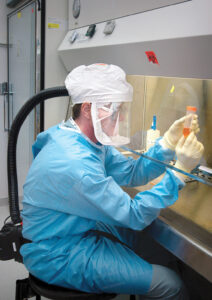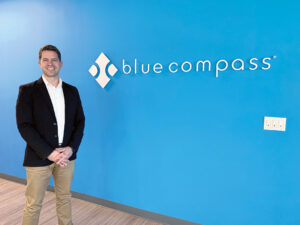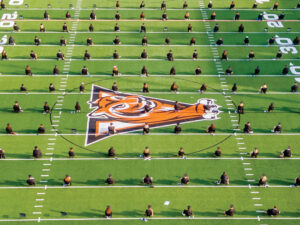A new normal — COVID after 3 years
3/1/2023A look back on the pandemic — and a glimpse of the future
Masks hanging from rearview mirrors. “Unprecedented times.” Clear plastic partitions. “Stop the spread.” Social distancing stickers scattered on floors.
Look around and you’ll find echoes of a global health crisis, its onset now three years in the past. Many of us disinfected our groceries, connected with others through screens, taped paper hearts in our windows. Others lost their health, their jobs, friends and family.
While the pandemic’s impact differed for each individual, many experiences were shared during a time when life was ruled by an unknown virus that forever altered the fabric of daily life — affecting healthcare, workplaces, schools, restaurants and every aspect of society.
As the world walked through uncertainty, leaders held to the oft-repeated maxim of accepting the “new normal.” The question remains: What is the new normal? And where do we go from here?

Dr. Amerlon Enriquez is a pulmonology and critical care specialist in the Des Moines area. Photo submitted
The front lines
“When COVID hit…”
So begins a new chapter of many personal histories. When the novel coronavirus reached Iowa, it wasn’t a surprise. Medical teams had begun to brace themselves as Europe and other metropolises underwent their initial surges. Among them: Dr. Amerlon Enriquez, a pulmonary and critical care specialist who spent many long days in the ICU.
“The atmosphere was mostly dread,” he recalled. “We’re going to battle, and we don’t have the right gear, we don’t have the right equipment, we don’t have the right artillery to combat this.”
At the same time, Enriquez said, the impending health crisis provoked an air of challenge among his colleagues.
“This is our calling. We’re trained to do this, even though we don’t know what we are entering,” he said. “Ready to strap your boots and fasten your belt.”
Instead of boots and a belt, their armor came in the form of polyester and latex: a gown, double masks and gloves. Sometimes, a face shield. Other times, a larger facepiece akin to a football helmet.
“It’s hooked to a hose in the back with a respirator, so you’re like an astronaut going into the room,” Enriquez said.
Rinse and repeat. For patients in isolation, hospital staff donned new gear for each visit. Rounding took time. Delirious patients needing care couldn’t receive it at a moment’s notice.
“We said to our nurses, ‘Your safety first,’ ” Enriquez said. “You can’t save any more people if you get COVID also, so don’t rush in the room without the proper protection. Don’t be a hero.”
Heroic or not, serving on the front lines of a pandemic had its obvious risks. At the end of each day, Enriquez’s wife urged him to change clothes at the door before entering their home.

An example of a powered air purifying respirator (PAPR) used by Enriquez during the pandemic. Photo by James Gathany/CDC
“There are days after work where you go, ‘Do I have the virus? Should I sleep in a different bedroom?’ So there were days where we did that. We were so uncertain of what was happening.”
Enriquez recalled his first time intubating a patient: laryngoscope in hand, peering directly into the patient’s mouth and larynx, praying his flimsy mask would somehow protect him.
“There’s no cure, no protection for us, no vaccine, so you’re always dreading that you’ll also get the virus. There’s nobody to take care of you except you.”
Still, at the end of each day, at least Enriquez could go home. Like many, his hospital had reached capacity. Only the sickest of the sick were admitted, and with visitors prohibited, many died a lonely death.
“So the nurses took the responsibility, especially if we had a dying patient, to be in the room to hold the patient’s hand when they die,” he said. “I think, to me, that is dedication to the fullest degree.”
As days passed, plans of attack changed quickly: intubation, antibiotics, hydroxychloroquine, and the list goes on. Enriquez’s hospital even participated in a Mayo Clinic study involving blood transfusion from recovered patients. It didn’t work.
Of course, hindsight is 20/20. Knowing now that the virus is rarely transmitted from clothes and surfaces, Enriquez said he could have done without the constant anxiety. But if there’s anything he really could have changed, he said, it would have been the controversy.
“The community was divided because it was politicized. I mean, just doing a mask,” he said. “And don’t get me started on the vaccine.”
Today, a strained healthcare system is still struggling to recover. After many nurses burning out and others retiring early, a shortage continues.
“The good thing is that we learned a lot from this,” Enriquez said, citing everything from research on oxygenation to lung physiology. “And maybe also the attitude of the people to respect each other’s beliefs.”

Drew Harden is the CEO and co-founder of Blue Compass, one of many companies that navigated remote work during COVID. Photo by Sofia Legaspi Dickens
Working from where?
Like many companies, local marketing agency Blue Compass switched to a remote workplace in March 2020. For an office that had operated fully in-person, the shift to remote was relatively seamless, albeit not ideal.
“It’s difficult to fully understand someone when they are rendered as pixels on the screen; there’s something special about being in person with someone,” said CEO Drew Harden, pointing out barriers to communication and spontaneous brainstorming.
Amid the apprehension and confusion of those early days, Harden wondered whether clients would cut budgets or pause projects. His biggest concern, however? The company’s culture.
Many business leaders endeavored to maintain employee connections during the pandemic, but Harden took it further. He frequently video-chatted with his dozens of team members — individually — just to check in and let them know he was there. Morning meetings began with words of encouragement for a different team member each day, later compiled on cards and mailed. On numerous occasions, Harden and his business partner drove to employees’ homes to drop off gifts or lunches.
“We never told them we were coming, so it was always a crazy surprise, but everyone enjoyed it,” Harden said. “It was just really important for us to maintain the sense of joy and communication that we always had, especially through that uncertain time.”
As 2020 went on, Blue Compass employees slowly started returning to the office, and, by early 2021, everyone had returned. Harden had never asked them to.
“I think our positive culture eventually led people back,” he said.
Three years after the global shutdown, Harden said the pandemic added flexibility to how their office operates. Employees now have the option to work from home on Fridays. Teams have more video chats and online tools in their arsenal. But, largely, Blue Compass remains in person.
“There’s nothing wrong with working remotely; it’s a great solution for many people,” Harden said. “But it’s very difficult for an organization to differentiate themselves when everyone works remotely — because working at your kitchen table at one job is very similar to working at your kitchen table for another job.”
Not all companies came out the other side of the pandemic as unaltered as Blue Compass. As the workforce continues to embrace hybrid/remote alternatives, many Des Moines offices remain half-full. Downtown cornerstones like Nationwide and Wells Fargo have left their buildings for good.
Weekly reports from property security company Kastle show that workplace occupancy rates continue to hover around 50%. Nonetheless, Harden believes all three options — remote, hybrid and in-person — are here to stay.
“The pendulum has swung really far toward remote, and many employers thought that was a benefit that everyone wanted. But over the past couple of years, everyone has realized that remote isn’t always everything it’s cracked up to be, and people have started to want in person more. All three approaches have their pluses and minuses. I think it depends on the organization, which one they choose, but all three will continue.”

Valley High School honored the Class of 2020 at Valley Stadium, with three separate ceremonies postponed to June 2020. Photo courtesy of Brian Abeling/WDMCS
Lessons learned in education
For Iowa’s K-12 public schools, spring break in 2020 lasted much longer than planned. When news broke in April that the 2019-2020 school year was finished for good, schools moved quickly.
Some districts, like Des Moines Public Schools, finished the year with online classes. Others, including West Des Moines Community Schools, provided voluntary enrichment opportunities for students.
“Those early days were really focused on: How do we support students? How do we even consider education for the remainder of the school year?” recalled Laine Mendenhall-Buck, a spokesperson for WDMCS.
That summer, schools formulated their game plans. By July, schools were required to submit their Return to Learn plans to the state. What normally would have taken several months to strategize in materials, curriculum and logistics were decided in a matter of weeks. Districts developed COVID-19 dashboards to track positive cases and exposure. Classrooms were rearranged and online/hybrid alternatives determined.
At every step, they encountered barriers: How would they continue to support students’ nutritional needs? What about families without reliable Wi-Fi access? Students without laptops?
And at each barrier, a new solution: Arrange meal pickup stations. Partner with internet companies to provide low-cost access. Install Wi-Fi extension towers at school buildings. Distribute thousands of Chromebooks to families across the metro.
“I think one big takeaway, overall, is that we had to think outside the box and be creative in how we were going to problem-solve,” Mendenhall-Buck said. “That really has extended beyond those early days because it made us change the way that we thought about learning.”
Whether students liked it or not, they were given an opportunity to work independently and take ownership of their learning.
“That kind of agency that students learned about advocating for themselves, learning what their learning style was, is something that has carried over throughout the years since COVID first began.”
Of course, Mendenhall-Buck was careful not to underplay the academic, social and emotional consequences of losing two months of learning and routine. Data shows student misbehavior has escalated. Academic performance has declined across the board. Educators burned out.
“I think it’s really difficult for us to understand the full impact to both students and staff,” she said. “You don’t just set aside the hard things that are happening at home when you walk into a classroom. So what we’re learning is we really need to embed that social-emotional support — that trauma has happened to students and to staff.”
The full effects of a disrupted educational system continue to be discovered. Still, three years later, students have largely persevered through an experience unlike any other.
“In an uncomfortable and unusual situation,” said Mendenhall-Buck, “students were resilient and adapted.”

Paul Rottenberg has been embedded in the Des Moines restaurant and hospitality industry since the 1980s, with eateries like Centro, Django and Zombie Burger falling under Orchestrate Hospitality’s umbrella. Photo submitted
Restaurants recover
“Adapt” was the mantra of the restaurant industry in 2020. Even for seasoned restaurateur Paul Rottenberg, nothing could have prepared him for March 17, when the entire industry came to a screeching halt.
“Moving at full speed, and then the next day, having everything be 100% dark — I think that was the most substantial thing initially, just being stunned by the magnitude of the situation,” said Rottenberg, founder of Orchestrate Hospitality and several Des Moines establishments.
Prior to COVID, Orchestrate comprised 700 employees across its properties.
“In 2020, in one moment, one press conference, they were all unemployed. And I was unemployed,” Rottenberg said. “We were pretty sure that some, if not all, of our businesses would end up going under.”
Naturally, online orders, takeout and delivery became an “astronomical amount of business.” During the lonely days of lockdowns, communities rallied around local eateries, supporting them from home by ordering in. But it wouldn’t have been enough to carry the industry through, according to Rottenberg.
“Most of us still wouldn’t be here if we hadn’t gotten government assistance,” he said. Nationally, more than 100,000 business owners received a portion of the $28.6 billion allocated to the Restaurant Revitalization Fund. “It never dawned on me as a restaurateur that the government was going to come in and bail me out… And I couldn’t have been more happy, grateful.”
The consequences of departing from dine-in have been substantial. In some Orchestrate restaurants, online ordering fees cost $100,000 more than pre-pandemic. Add that to the climbing cost of paper products — not to mention its effects on the environment.
“I think it’s going to take years to recover from the climate impact of all this garbage now that we’re sending out every night for takeout and delivery,” Rottenberg said. “It’s disheartening.”
Another factor is labor costs, which increased by up to 20% at Orchestrate. While growing price tags have been a wake-up call for consumers, Rottenberg cited the higher value of labor as one of the positive results of the pandemic.
“I think COVID did what the government couldn’t get done, which is get people’s wages raised in our industry and other industries that traditionally relied on low wages.”
Yet, restaurants continue to struggle with a shortage of willing workers. After layoffs at the onset of COVID, around 50% of Orchestrate employees returned. Today, the company operates with 500-600 employees, compared to its pre-pandemic staff of 700.
With many seasoned employees retiring early, the industry is also dealing with a new generation of employees: with less experience, more demands and a new sociology.
“We have to go back to hiring people and learning how to train people,” Rottenberg said. “You have managers that need to be retrained on how to manage in this new employee-controlled environment, where the employees are the ones calling the shots.”
In part, Orchestrate’s reduction in staff may be ascribed to hybrid/remote work and the changing downtown landscape.
When Rottenberg started operating in downtown Des Moines, north of 30 years ago, business was largely concentrated around lunchtime, serving a weekday workforce of 60,000. Weekend business was rare, and evening business confined to Friday and Saturday.
“Now we have an economy where we have to live almost entirely off evening business because lunch business is very weak,” he said, observing that lunch has moved to the suburbs, where people now both live and work.
Looking back, few areas of society were as hard hit by COVID as the restaurant industry, but Rottenberg doesn’t see it as all bad. He said he believes the industry has increased its preparedness for unknowns, scrutinized performance areas — and emerged managing businesses better.
“When you’re doing OK, you tend to get lax. So you have a wake-up moment, and then you start looking at everything and realizing the way you were doing things was easy, and you went on autopilot. And now you have to rethink every aspect of what you do.
“As an industry, I think we’re in for a long realignment. I’m glad I’m not just starting out. I think it’s going to be tough. But humans are pretty damn good at figuring stuff out.” ♦


















